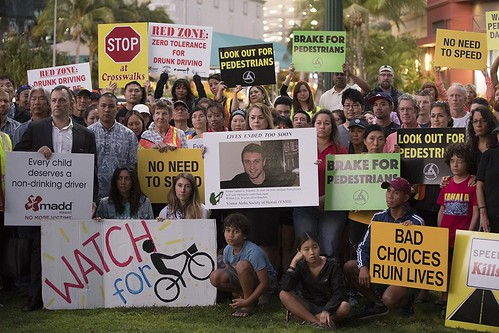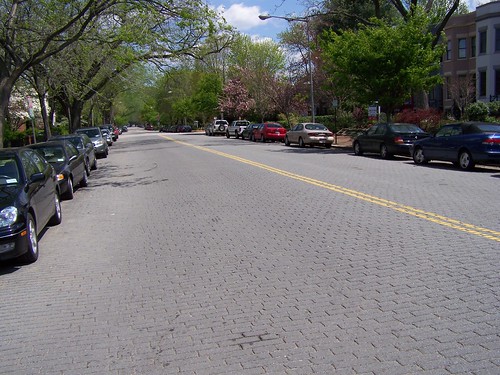Vigil in Honolulu reminds us that we take car crash deaths for granted
I didn't download a copy of the front page of yesterday's Honolulu Star-Advertiser that was posted at the Newseum. The top section of the paper featured a large photograph (below), of people protesting a recent crash where a drunk driver driving errantly killed three people.

People gathered for sign waving and three minutes of silence during Wednesday’s vigil for the three pedestrians who were fatally hit by a truck driver at the corner of Ala Moana Boulevard and Kamakee Street on Monday. Video and photos by George F. Lee / glee@staradvertiser.com
The article also had a video. (The paper has a strict registration requirement for most articles, but the photos and video happen to bee open access.)
There weren't a lot of people at the vigil, about 100, according to the article, but the way the photos were shot accentuated the crowd.
Last week, Smart Growth America released a report, Dangerous By Design 2019, about the rise in traffic fatalities and the states with the worst statistics.
This general point is also discussed in a long ago New Yorker; article by Malcolm Gladwell, "Wrong Turn: How the fight to make America's highways safer went off course." He argues that highway systems are designed so that people don't have to pay that much attention to what they are doing, cars are better designed and include safety devices to reduce the impact and damage from inevitable accidents, but as a result, people develop a kind of "inattentional blindness." From the article:
There is a part of driving that is automatic and routine. There is a second part of driving that is completely unpredictable, and that is the part that requires attention." This is what Simons found with his gorilla, and it is the scariest part of inattentional blindness. People allow themselves to be distracted while driving because they think that they will still be able to pay attention to anomalies. But it is precisely those anomalous things, those deviations from the expected script, which they won't see.While the SGA report asserts that the reason for much of the deaths is poor street design, I think the argument is more complicated. It's not as much street design and specific geometry and traffic engineering as it is the fact that the overall road network as a product of system design, based on precepts that prioritize fast speeds.
Marc Green, a psychologist with an accident-consulting firm in Toronto, once worked on a case where a woman hit a bicyclist with her car. "She was pulling into a gas station," Green says. "It was five o'clock in the morning. She'd done that almost every day for a year. She looks to the left, and then she hears a thud. There's a bicyclist on the ground. She'd looked down that sidewalk nearly every day for a year and never seen anybody. She adaptively learned to ignore what was on that sidewalk because it was useless information. She may actually have turned her eyes toward him and failed to see him." Green says that, once you understand why the woman failed to see the bicyclist, the crash comes to seem almost inevitable.
1. Yes, there is bad street design.
2. But we've built a broader system to privilege high speed motor vehicle traffic
3. Which isn't necessarily a matter of bad design per se.
4. More importantly, we've failed to create a differentiated system of traffic, where streets are engineered in terms of land use context.
5. And these problems are complemented by a legal system that favor motor vehicle operators over vulnerable users accentuate the problems.
The Smart Transportation Guidebook does a good job of outlining how the road system can be better planned and engineered, taking into account (1) land use context and (2) the purpose of the road (regional or local traffic) and then what we might call "tuning" (3) roadway characteristics; (4) road side characteristics; and (5) desired operating speed of motor vehicles accordingly.
I think that the guidebook needs to go even further with its recommendations.

For example, one way I argue that we can do this in cities is to use asphalt brick/Belgian block, which provides visual, aural and physical cues to drive more slowly. I think as a start we should use such paving materials for streets in commercial districts, and by schools, libraries, parks and other civic assets.

Belgian block, 900 block, South Carolina Avenue SE.
With regard to driver behavior, the problem is how motor vehicle codes have been shaped to favor motor vehicle traffic over the most vulnerable users (pedestrians and cyclists), and how unless a person is grossly negligent and/or impaired, there are few substantive penalties for motor vehicle crashes involving pedestrians and cyclists.
(I guess you can argue that's an element of design too.)
By contrast, in the Netherlands, rather than presuming that the most vulnerable user is at fault, there the laws put the onus on the least vulnerable user, that is the motor vehicle operator.
This is why in Vision Zero agendas, I have a section "Enforcement/Traffic Engineering," with one recommendation calling for this to be changed ("Updating Vision Zero approaches").
Labels: car culture and automobility, policing, public safety, public space management, traffic engineering, traffic safety and enforcement, transportation planning, urban design/placemaking



1 Comments:
Hi everyone, Are you into trading or just wish to give it a try, please becareful on the platform you choose to invest on and the manager you choose to manage your account because that’s where failure starts from be wise. After reading so much comment i had to give trading tips a try, I have to come to the conclusion that binary options pays massively but the masses has refused to show us the right way to earn That’s why I have to give trading tips the accolades because they have been so helpful to traders . For a free masterclass strategy kindly contact maryshea03@gmail.com for a free masterclass strategy. She'll give you a free tutors on how you can earn and recover your losses in trading for free..
Post a Comment
<< Home